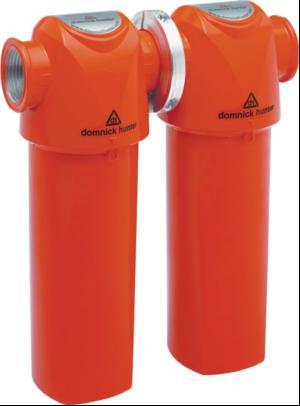

|
Edward Lowton
Editor |


|
ARTICLE
Are all compressed air filters the same?
25 January 2013
The origins of modern compressed air filtration can be traced back to domnick hunter in 1963, the first company to use microfibre filter media for purification applications, changing the compressed air industry forever.

The origins of modern compressed air filtration can be traced back to domnick hunter in 1963, the first company to use microfibre filter media for purification applications, changing the compressed air industry forever.
The OIL-X filter range was the first to fully utilise this ground breaking technology and has always been synonymous with high quality compressed air.
Parker domnick hunter has continued to develop both the compressed air filter and the standards governing compressed air quality. Constantly innovated, OIL-X EVOLUTION has become the leading technology for compressed air filtration, providing the exact balance between air quality, energy efficiency and low lifetime costs.
Air Quality
The primary reason for using a compressed air filter is to remove contamination and improve air quality. Parker domnick hunter's Design Philosophy of Air Quality & Energy Efficiency has led to filtration products that provide:
Are all compressed air filters the same?
Today, there are many compressed air filters available. Visually similar, and on paper, their performance may appear identical, but in operation, a very different story is told.
Compressed air filters are often bought with a compressor as part of a package deal and therefore, selected based upon total purchase cost, with little or no regard for the delivered air quality or the total cost of ownership.
If the running costs of a filter are considered, then typically, the differential pressure or dP values printed in literature will be used.
However, these values are only representative of the filter in an "as new" condition, and do not take into consideration the initial and on-going blockage characteristics of the filters which can vary significantly.
Differential Pressure - An accurate picture (see Fig 1)
In comparative testing of OIL-X EVOLUTION filters against five commonly available alternative filters, the blockage characteristics and therefore the true differential pressure of each filter can be demonstrated.
The accurate running costs of a filter (see Fig 2)
Using the below data, a true picture of energy consumption can be evaluated.
Low Lifetime Cost (see Fig 3)
A filter with a low purchase price may not always turn out to be the most cost effective solution.
Reduced CO2 Emissions
The use of electrical energy has a direct impact on the generation and release of CO2. By significantly reducing the energy consumption of its products, Parker can also help you to protect the environment by lowering your carbon footprint.
The OIL-X filter range was the first to fully utilise this ground breaking technology and has always been synonymous with high quality compressed air.
Parker domnick hunter has continued to develop both the compressed air filter and the standards governing compressed air quality. Constantly innovated, OIL-X EVOLUTION has become the leading technology for compressed air filtration, providing the exact balance between air quality, energy efficiency and low lifetime costs.
Air Quality
The primary reason for using a compressed air filter is to remove contamination and improve air quality. Parker domnick hunter's Design Philosophy of Air Quality & Energy Efficiency has led to filtration products that provide:
- Highest air quality
- Lowest power consumption
- Lowest operational pressure loss
- Lowest total cost of ownership
- Lowest CO2 emissions
Are all compressed air filters the same?
Today, there are many compressed air filters available. Visually similar, and on paper, their performance may appear identical, but in operation, a very different story is told.
Compressed air filters are often bought with a compressor as part of a package deal and therefore, selected based upon total purchase cost, with little or no regard for the delivered air quality or the total cost of ownership.
If the running costs of a filter are considered, then typically, the differential pressure or dP values printed in literature will be used.
However, these values are only representative of the filter in an "as new" condition, and do not take into consideration the initial and on-going blockage characteristics of the filters which can vary significantly.
Differential Pressure - An accurate picture (see Fig 1)
In comparative testing of OIL-X EVOLUTION filters against five commonly available alternative filters, the blockage characteristics and therefore the true differential pressure of each filter can be demonstrated.
The accurate running costs of a filter (see Fig 2)
Using the below data, a true picture of energy consumption can be evaluated.
Low Lifetime Cost (see Fig 3)
A filter with a low purchase price may not always turn out to be the most cost effective solution.
Reduced CO2 Emissions
The use of electrical energy has a direct impact on the generation and release of CO2. By significantly reducing the energy consumption of its products, Parker can also help you to protect the environment by lowering your carbon footprint.
MORE FROM THIS COMPANY
- Can high performance air dryers be environmentally friendly?
- Air quality standard exceeded
- Easy access to effective compressed air treatment solutions for rail operators
- Dispensable thermal gel offers vertical tackiness
- Stamp of approval for Parker Medical Grade Breathing Air Purifiers
- Escaping air:Major drain on resources
- The OIL-Xplus ADVANTAGE – taking energy saving to the next level
- Compressed air drying solutions for every application
- Parker Chomerics introduces SOFT-SHIELD 4840 and 4860
- Compressed air for point of use
RELATED ARTICLES
- No related articles listed
OTHER ARTICLES IN THIS SECTION

















